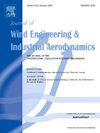Deterministic and constrained stochastic models of thunderstorm winds
Abstract
Strong winds are one of the major causes of structural damage inflicted by thunderstorms. Specialized agencies and research groups regularly provide post-disaster damage assessment reports after a severe thunderstorm has passed over an area. If the observed structural damage was caused by severe winds, an assessment of the characteristic wind gust is provided based on the wind engineering analysis of the damage. Given that high-frequency anemometer measurements of wind speed are practically never available at or close to the observed damage, this study investigates the following question: What would an anemometer measure during the storm if it was installed at the location of the observed damage? This paper presents two models for thunderstorm wind time series reconstruction based on the observed damage. One model is a simple analytical equation that provides a closed-form solution to relate the estimated wind gust that caused damage to the mean wind speed and instantaneous peak during the storm. Another model is uses constrained stochastic simulations that are based on power spectral density of turbulent winds to reproduce a thunderstorm wind record that is in statistical sense indistinguishable from a measured wind. The constrain in the stochastic model is the value of the reported dameging wind gust. The models are validated against measured thunderstorm wind records and used to reconstruct thunderstorm wind time series from the damage data.

 求助内容:
求助内容: 应助结果提醒方式:
应助结果提醒方式:


